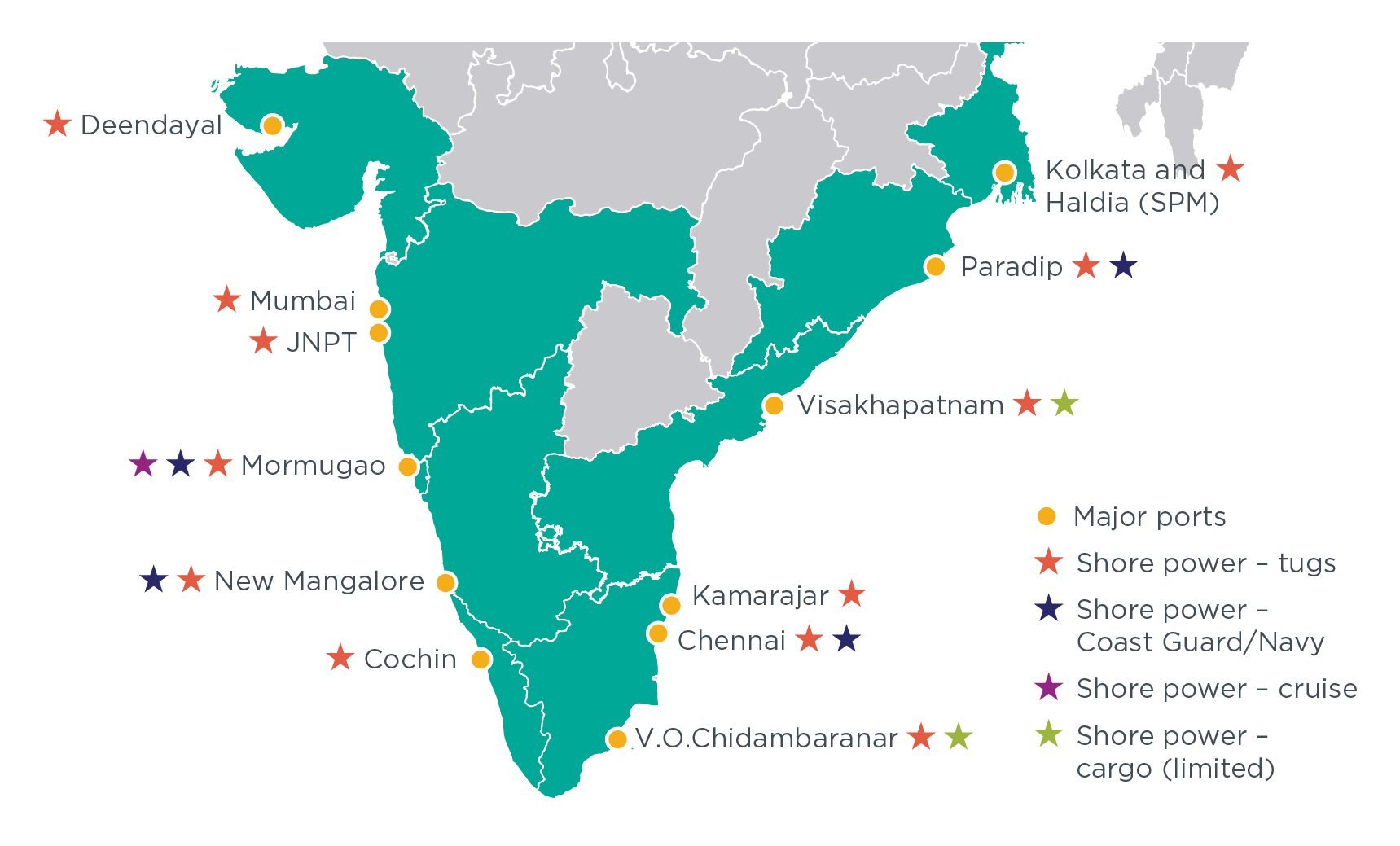Blog
India’s plan to expand shore power infrastructure at major ports
Along its 7,500 km of coastline, India has 12 ports designated as major ports (owned by the national government) and 217 non-major ports (owned by the respective state governments). Nearly 70% of air the pollution at major ports is from ships at berth or at anchor. The average time spent by ships while berthing at major Indian ports was 2.25 days in FY 2021–22, more than twice the average globally, 1.05 days in 2021.
The maritime sector is crucial for India. It carries 95% of the country’s trade volume and 65% of its trade value. Because of this, and as projections suggest a fivefold increase in seaborne tonnage by 2047, ports have been earmarked to play one of the leading roles in India’s decarbonization efforts.
Last spring, the Ministry of Ports, Shipping, and Waterways (MoPSW) released the “Harit Sagar” Green Port Guidelines, which detail a range of decarbonization initiatives at major ports. Among the land-based initiatives are electrification of port vehicles and cargo-handling machinery and phased adoption of alternative fuels by trucks that transport cargo. To reduce sea-based emissions, Harit Sagar (which is green ocean in Hindi) endorsed the use of shore power and cleaner alternative fuels to operate port crafts.
While the Harit Sagar initiatives are not legally binding, ports can earn carbon credits for use in a proposed carbon credit trading scheme. The environmental performance of the major ports will be evaluated by the MoPSW annually based on set near-term—30% by 2030—and long-term—70% by 2047—targets for reducing carbon intensity in terms of carbon dioxide (CO2) emissions per ton of cargo. These targets were established with FY 2022–23 as the baseline year, and major ports were tasked with preparing the requisite greenhouse gas emissions inventory in conjunction with an expert agency.
The adoption of cleaner alternatives for port vehicles, port crafts, and trucks is still at a nascent stage, but progress has been made in shore-to-ship power supply. Harit Sagar envisions the rollout of shore power in three phases:
- Phase 1, by 2023, port crafts (tugs, pilot boats, and survey and mooring boats)
- Phase 2, by 2024, Coast Guard/Navy and India-flagged coastal vessels
- Phase 3, by 2025, export/import foreign-flagged cargo vessels
By the end of April 2024, all major ports in India had developed adequate infrastructure for shore power supply to port crafts (Figure 1). Additionally, some ports—Mormugao, New Mangalore, Chennai, and Paradip—also had the infrastructure to supply to Indian Navy/Coast Guard vessels. Note that ships are not yet mandated to use the available grid power. This contrasts with the European Union, where certain types like container ships and passenger ships (including cruise) will be mandated to do so by 2030 via the FuelEU directive. While ships at Indian ports are only likely to switch to shore power if it’s financially beneficial, the MoPSW has raised the possibly of introducing incentives in the future such as queue priority and rebates on berth dues for vessels that have shore power receptors installed.
Figure 1. Major ports in India with shore power facilities
Sources: MoPSW (2020), Rajya Sabha (2021), and MoPSW (2023)

Shore power technology not only helps to minimize the climate impact of port operations, it also brings public health benefits by reducing the use of bunker fuels. An ICCT study estimated the air quality and health benefits of shore power in two port cities in the United States using our global online Port Emissions Inventory Tool (goPEIT). For the Port of Seattle, shore power for ocean-going vessels and harbor craft was expected to reduce direct CO2, nitrogen oxides (NOx), and particulate matter (PM2.5) emissions from those vessels by 68%, 85%, and 75%, respectively. (Remaining emissions were because ships still use fuel in the port while entering, departing, and manoeuvring.) Using shore power was estimated to reduce the average PM2.5 concentrations near the port by up to 83%, which would result in an estimated $27 million in public health benefits annually.
For the Port of New York/New Jersey, connecting ocean-going vessels and harbor craft to shore power and electrifying drayage trucks was estimated to reduce direct CO2, NOx, and PM2.5 emissions from those sources by 64%, 66%, and 68%, respectively. The average PM2.5 concentration levels in the port’s vicinity would be expected to fall by up to 65%, and that would translate to an estimated $150 million in public health benefits per year. Given that the population density of major Indian port cities (e.g., Mumbai, 73,000/mi2 and Kolkata, 63,000/mi2) is far greater than that of New York (26,931/mi2) and Seattle (9,357/mi2), the public health benefits associated with shore power deployment could be higher in India.
The extent of the life-cycle reduction in ship emissions that result from use of shore power in India will be primarily dependent on the composition of the electricity grid. As of FY 2023–24, nearly 76% of grid power is generated from fossil fuel sources (primarily coal, with gas and oil); the remainder comes from renewable sources (wind, solar, hydro, and biomass) and nuclear energy. At present, India’s grid emission factor for CO2 stands at about 710 g/kWh, slightly higher than ship auxiliary engines operating on low-sulfur fuel oil (approximately 690 g CO2/kWh). However, it’s projected that with increasing use of renewable sources for power generation, India’s grid emission factor could be reduced to 548 g CO2/kWh by FY 2026–27 and 430 g CO2/kWh by FY 2030–31. Thus, while the overall carbon intensity of shore power use will be higher than that of burning marine fuel in the short term, the anticipated drop in the grid emission factor will make using shore power an increasingly attractive emissions-reduction option by later in this decade.
Because all major ports are in the exploration phase of deploying shore power technology, conducting a formal emissions inventory using tools like the ICCT’s goPEIT can be useful in supporting detailed recommendations about how to prioritize installations. Such an inventory would also allow decision-makers to identify, quantify, and compare other sources of port-based emissions and help port operators devise a plan for reducing and eliminating emissions from these sources in line with the Harit Sagar targets.
The ICCT’s goPEIT is free to use. Researchers and port representatives can obtain a username and password by clicking on “Request an account.” Additionally, the ICCT can help ports to evaluate the costs and benefits of different alternative fuel technology options and design transition pathways in line with India’s economy-wide decarbonization targets. We encourage those interested in establishing baseline emissions inventories for Indian ports and analyzing the cost-effectiveness of alternative fuel options to get in touch with us.
Authors
Related Publications

Analyzes the potential of a tax on individuals who fly often to raise revenue for the decarbonization of aviation.


